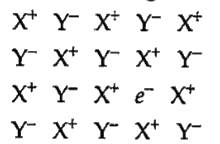Give an example of compound which has pπ−dπ bonding?
The correct Answer is:B
To find an example of a compound that exhibits p-pi d-pi bonding, we can analyze the sulfate ion (SO₄²⁻). Here’s a step-by-step breakdown of the reasoning:
Step 1: Identify the Compound
The compound we will consider is the sulfate ion, SO₄²⁻.
Step 2: Determine the Valence Electrons
Sulfur (S) has 6 valence electrons, and each oxygen (O) has 6 valence electrons. Since there are four oxygen atoms, we have:
- Sulfur: 6 electrons
- Oxygen: 4 × 6 = 24 electrons
- Total: 6 + 24 = 30 electrons
- Considering the 2- charge of the sulfate ion, we add 2 more electrons: 30 + 2 = 32 electrons.
Step 3: Calculate the Steric Number
The steric number can be calculated using the formula:
Steric Number=Number of atoms bonded to the central atom+Number of lone pairs on the central atom
For SO₄²⁻:
- Sulfur is bonded to 4 oxygen atoms.
- There are no lone pairs on sulfur in this ion.
Thus, the steric number is:
Steric Number=4+0=4
Step 4: Determine the Hybridization
A steric number of 4 corresponds to sp³ hybridization. In the case of SO₄²⁻, sulfur undergoes sp³ hybridization to form four equivalent hybrid orbitals.
Step 5: Analyze Bonding
In the sulfate ion, sulfur forms sigma bonds with the oxygen atoms using the sp³ hybridized orbitals. Additionally, sulfur can utilize its unhybridized d-orbitals (3d) to form p-pi d-pi bonds with the oxygen atoms.
Step 6: Identify the p-pi d-pi Bonding
In the sulfate ion:
- The oxygen atoms have unpaired p orbitals (2p) that can overlap with the d orbitals of sulfur.
- This overlap results in p-pi d-pi bonding, which is a characteristic of the resonance structures of the sulfate ion.
Conclusion
Thus, the sulfate ion (SO₄²⁻) is an example of a compound that exhibits p-pi d-pi bonding.
---
The compound we will consider is the sulfate ion, SO₄²⁻.
Sulfur (S) has 6 valence electrons, and each oxygen (O) has 6 valence electrons. Since there are four oxygen atoms, we have:
- Sulfur: 6 electrons
- Oxygen: 4 × 6 = 24 electrons
- Total: 6 + 24 = 30 electrons
- Considering the 2- charge of the sulfate ion, we add 2 more electrons: 30 + 2 = 32 electrons.
The steric number can be calculated using the formula:
Steric Number=Number of atoms bonded to the central atom+Number of lone pairs on the central atom
- Sulfur is bonded to 4 oxygen atoms.
- There are no lone pairs on sulfur in this ion.
Steric Number=4+0=4
A steric number of 4 corresponds to sp³ hybridization. In the case of SO₄²⁻, sulfur undergoes sp³ hybridization to form four equivalent hybrid orbitals.
In the sulfate ion, sulfur forms sigma bonds with the oxygen atoms using the sp³ hybridized orbitals. Additionally, sulfur can utilize its unhybridized d-orbitals (3d) to form p-pi d-pi bonds with the oxygen atoms.
In the sulfate ion:
- The oxygen atoms have unpaired p orbitals (2p) that can overlap with the d orbitals of sulfur.
- This overlap results in p-pi d-pi bonding, which is a characteristic of the resonance structures of the sulfate ion.
Thus, the sulfate ion (SO₄²⁻) is an example of a compound that exhibits p-pi d-pi bonding.
Similar Questions
Knowledge Check
Examine the given defective crystal :

Answer the following questions:
Give an example of the compound which shows this type of defect.AStoichiometric, F-centre, KBrBNon-stoichiometric, holes, NaClCNon-stoichiometric, F-centre, LiClDStoichiometric, holes, KCI
Give one example of 1315 compounds.
View SolutionGive an example of a compound in which hydrogen exists in (a) +1, (b) −1,
View SolutionHow many n-octene can show geometrical isomerism?
View SolutionWhich of the following has pπ−dπ bonding?
View SolutionWhich of the following has pπ−dπ bonding?
View SolutionGive an example of (a) a physical quantiy which has a unit but no dimensions. (b) a physical quantity which has neither unit no dimensions. (c ) a constant which has a unit. (d) a constant which has no unit.
View SolutionWhat do you understand by partial ionic character in a covalent bond? Give at least three examples of the compounds containing partially ionic covalent bonds.
View Solution
